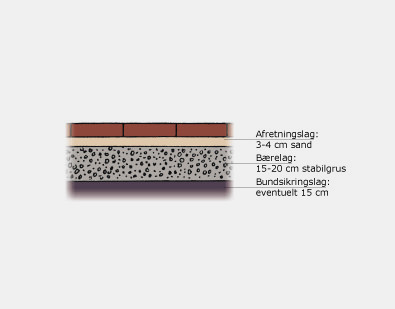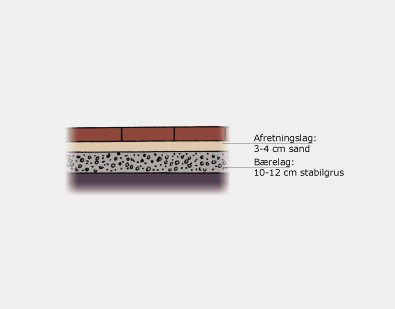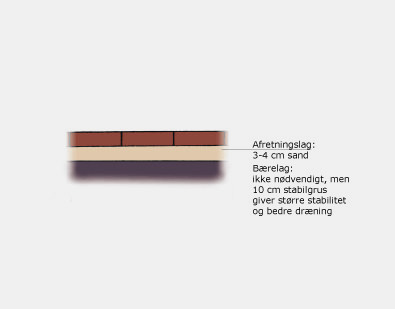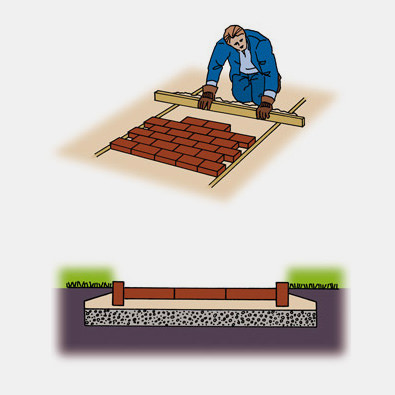Laying bricks and plaster
In order to ensure a beautiful and durable plaster surface, it's important to execute the previous works correctly, and fitting to the load, that will later by spread on the respective area.
The subsurface must be stable and even and at the same time rain water must be able to run down it. Should the water from the subsurface not be diverted, the surface is often moist, which can lead to the occurrence of higher spots and uneven area, due to sagging or flushing out the subsurface.
In the following texts you'll find tips and tricks for the laying process, as well as many other aspects concerning garden tiles and pavers.
Subsurface for garden bricks and pavers
Before the soil is removed, the area that shall be paved needs to be marked with stakes and string. The area that needs to be paved should lie somewhat above the lawn or beds. To obtain stable edges, the subsurface should be apprx. 25-cm wider than the ready surface.
The soil should be removed deep enough to take the strength of the base course, the adjustment course and the surface. In any case, top soils should be removed deep enough to reach a stable underground layer. The ground will be compressed with a roll or a slightly inclined shaker, from the centre to the sides.

For driveways and paths with moderate traffic:
Use pavers.
Base course
For the base course we use plaster sand or grit (not clay) with rough granulation, as this course supports the surface and keeps water in check.
The course should be evenly thick and compressed with a shaker from the sides toward the centre, so that the surface lies even and 3-4 cm under the surface level.
Adjustment course
Grit or sand for adjustment, with a granulation of 1-8 mm, is divided in an even, 3-5-cm high course, and adjusted by using a completely straight adjustment plank.
The adjustment plank is steered by adjustment tracks in the form of thick pipes or planks that are positioned correctly on both sides of the surface, at the height of the ready surface, minus the surface thickness, but with plus approx. 1 cm compression added.

For terraces or areas with little traffic, i.e. carports or access areas:
Use pavers or garden bricks.
Fleece
Between the base course and the adjustment course or under the base course you can lay fleece, in order to make the underground more stable.
Fleece SHOULDN'T be laid between the adjustment course and the surface, because the surface won't be fixed in this way. Placing fleece between the adjustment course and the surface doesn't prevent weeds from growing, because they mostly grow in the sand within joints.
Quantity
Grit and sand reduce after compression by 15-20 %. Please consider this before you place an order.

For garden paths:
Use garden bricks or pavers.
Laying garden bricks and pavers
Before the laying process, the compressed adjustment layer must be controlled once more with the adjustment brush.
Laying
The pavers and garden bricks are now laid with 2-5-mm wide joints in the chosen pattern, with an inclination of apprx. 1 cm per metre.
The strings must be taut, so that they can hold the height and direction of the stones in check. For the laying process of pavers and garden bricks, the use of hammers or stamping tools is forbidden.
At the end, spread a thin layer of dry beach sand or fine-grained quartz sand. The sand will be swept in the joints and the surface needs to be processed with a rubber-sole shaker. In the end, sand needs to be spread and shaken again, until the joints are completely filled and the stones are fixed.
Edges
The paving edges will be secured against slipping with compressed soil. The edges can also be fixed with upright laid pavers or garden bricks. As an alternative, an arched edge can be laid on pressed wooden planks, only half the height of the stones.

The edges of the path are secured here through upright laid garden bricks and a compressed adjustment course over the surface.





